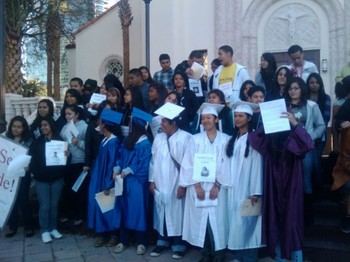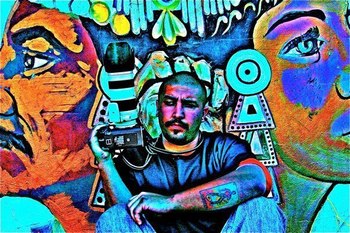Dreaming Out Loud! Youth Activists Spoke About Their Fight for Education, Immigrant Rights and Justice Through Media and Art (Part Four)
/This is the final installment in a four part series, written by Arely Zimmerman and Sangita Shreshtova from the USC Civic Paths Project, concerning the young activists who are supporting the Dream Act. This research was funded by the MacArthur Foundation and is part of the work of the Youth and Participatory Politics Network.
New Media and Movements
Dreamer youth have
also used new media to grow their movement on a national scale. Between 2009-2010,
youth organized many protest, including sit-ins at Congressional offices,
hunger strikes, marches, and symbolic graduations. They used new media to
exponentially amplify their voices through sophisticated and strategic use of live
streams, blogs, user generated video portals and social media like Facebook and
Twitter. For example, in June 2009, the founders of Dreamactivist.org, and United We Dream,
organized 500 youth to participate in the National
DREAM Act Graduation in Washington DC. This protest combined
a symbolic ceremony with legislative lobbying (Behary 2009).

On the same day, solidarity graduations took
place in Arizona, California, Florida, Illinois, Indiana, Kentucky,
Massachusetts, Montana, New Jersey, New York, North Carolina, and Texas (Dream Activist 2009).

source:
http://blogs.orlandosentinel.com/news_hispanicaffairs/tag/dream-act
In another widely publicized campaign, on
January 1, 2010, four undocumented youth from Miami Dade College began a
4-month, 1500-mile-trek to Washington, DC to advocate for the DREAM Act. In
what they aptly called the "Trail
of DREAMs," the youth documented and mobilized support
for their their walk through blogging, Facebook, YouTube, and twitter. Along
their journey, they gathered 30,000 signatures to bring to President Obama.
Watch the trail of dreams video here:
Despite all these efforts, the DREAM Act has yet
to pass, and undocumented youth continue to be deported. In the face of this
continuing crisis, the youth have used a combination of direct action and media
activism to highlight (and render visible) detentions and deportations, which
have generally received little public attention (Kohli 2011). They have staged rallies and sit-ins at detention centers, ICE offices, and
have even targeted banks that invest in private prisons to directly confront
the institutions invested in the immigrant detention and deportation system (Foley 2011). Grass roots new media messaging campaigns have been crucial to these action as
youth use Facebook, Twitter, and microblogging to share the stories of, and
garner support for, those detained and fighting deportation.
The story of Matias Ramos,
, an undocumented youth and co-founder of United We Dream, is a powerful
example of such mobilization. On the morning that an electronic monitoring
device was placed on his ankle, Matias Ramos posted a photo of himself on
Twitter and announced that he had been given two weeks to leave the country (Berenstein 2011).

source: http://americasvoiceonline.org/blog/entry/dream_activist_matias_ramos_scheduled_for_deportation/
Ramos and his supporters were able to gain high
visibility for his case, to the point where it was even called a "high
profile challenge to the White House's new deportation guidelines."
Stories like these are transmitted through many overlapping social media
networks connecting campus organizations, community groups, sympathetic media
and allies, providing links to petitions and online donations.
Nancy Meza is a key
media strategist for the END our Pain campaign. At DREAMing Out Loud!
she discussed the importance of
combining both new media and traditional media strategies to shape the movement
messaging. To Nancy, social
media is a space where "we can 'freely' express ourselves, push our messaging
forward... in terms of Twitter and Facebook." At the same time, Nancy stressed the need to complement new
and more traditional media as she continued: "Our organization doesn't even own
a camera...With whatever resources we have...I have a blackberry on a month to
month plan...So I think for us, it's really been about how we use traditional
media and how we mix it in". New
media has allowed for youth to shape their message in a more democratic and
participatory fashion. They are, however, increasingly conscious of the need to
be strategic about its use. For example, Nancy explained that a lot of effort
goes into coming up with a Twitter hashtag for an event. Is it accurate? Is it catchy? Will it
travel? Often, Twitter is a good way to catch the attention of more traditional
media, she explained. To her, the key is arriving at the happy medium between
locally constructed messaging and coordinating a coherent frame that can
translate to major media outlets.
Concluding
Thoughts:
At the heart of the event were the stories that
the panelists shared and accounts of how stories inspired activism. Pocho
1, a internationally recognized photographer, recalled how
photography shaped his activism and his reformation from a gang member to a
social activist: "I started telling stories...I wanted to tell their story...I
started hanging out with artists...I picked up a camera...I went crazy with
it...shoot it everyday... tell people's stories". Now Pocho 1 documents the Dream
movement, using his camera and social media as a form of social commentary and
social activism.

source: http://www.pocho1.com/#!
DREAMing
Out Loud! provided many insights into how young people
use new media to participate and mobilize in their communities. In many ways, the
event highlighted the great democratizing potential that new media has,
especially when it can be used to provide a platform to amplify the voices of
youth who are marginalized from the mainstream political process.
Behary, Samya. "Students
storm Capitol Hill for National Dream Act Graduation Day," Immigration Impact, June 25, 2009.
Berestein, Leslie Rojas. "A High-Profile Challenge to the White House New Deportation Guidelines," MultiAmerican, September 21, 2011, multiamerican.scpr.org/2011/09/a-high-profile-challenge-to-the-white-houses-new-deportation-policy.
DREAM Activist, "DREAM for
America: National DREAM Act Graduation Day - June 23, 2009," press release, June 21, 2009
dreamactivist.org/blog/2009/06/21/nationalgraduation/.
Foley, Elise. "Immigrants to Wells Fargo: Stop investing in For-Profit Detention," The Huffington Post, October 17, 2011.
Kohli, Aarti Peter l. Markowitz, and Lisa Chavez, "Secure Communities by the Numbers:
An Analysis of Demographics and Due process," Chief Justice Earl Warren Institute
on Law and Social Policy Research Report, October, 2011.
Sangita Shresthova is currently the Research Director of the Media Activism and Participatory Politics (MAPP) Project at USC. She is a Czech/Nepali international development specialist, filmmaker, media scholar, and dancer with extensive interdisciplinary qualitative research experience. She holds a Ph.D. from UCLA's Department of World Arts and Cultures, and a MSc. degree from MIT's Comparative Media Studies program where she focused on popular culture, new media and globalization. She also earned a MSc. in Development Studies from the London School of Economics and Political Science (LSE). While at LSE, her work focused on the educational communication components of international development interventions. Her scholarly writing has been published in several journals, and her work on global participatory aspects of Bollywood dance was recently released as a book by SAGE Publications.
Arely Zimmerman, a Melon Post-Doctorate Fellow at the USC Program for Environmental and Regional Equity, holds a doctorate in political science from UCLA. Her scholarship engages overlapping research areas of U.S. Latino/a studies, race and ethnicity, social movements, transnational, media, and feminist studies. Before joining PERE, she held a postdoctoral appointment at USC's Annenberg School for Communication and Journalism, where she examined how new forms of social and digital media are reshaping modes of civic engagement amongst Latino, immigrant, and undocumented youth. As part of her ongoing concerns with issues of identity and citizenship in transnational contexts, Arely's manuscript in progress, "Contesting Citizenship across Borders: Central Americans in the United States" details Central American migrant communities' struggles for citizenship and inclusion across multiple nation-states through transnational social movement and community activism.


























